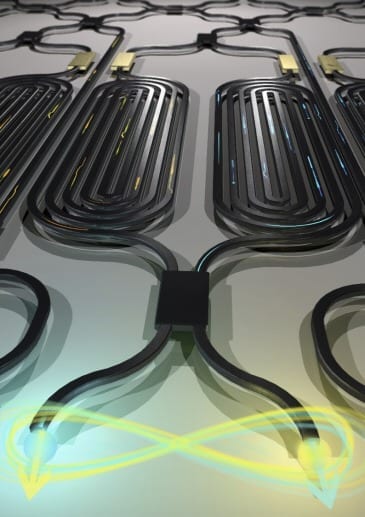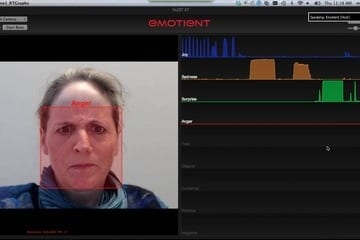
Amherst College Physicists Create Synthetic Magnetic Particle
Nearly 85 years after pioneering theoretical physicist Paul Dirac predicted the possibility of their existence, an international collaboration led by Amherst College Physics Professor David S. Hall ’91 and Aalto University (Finland) Academy Research Fellow Mikko Möttönen has created, identified and photographed synthetic magnetic monopoles in Hall’s laboratory on the Amherst campus. The groundbreaking accomplishment paves the way for the detection of the particles in nature, which would be a revolutionary development comparable to the discovery of the electron.
A paper about this work co-authored by Hall, Möttönen, Amherst postdoctoral research associate Michael Ray, Saugat Kandel ’12 and Finnish graduate student Emmi Ruokokski was published today in the journal Nature.
“The creation of a synthetic magnetic monopole should provide us with unprecedented insight into aspects of the natural magnetic monopole—if indeed it exists,” said Hall, explaining the implications of his work.
Ray, the paper’s lead author and first to sight the monopoles in the laboratory, agreed, noting: “This is an incredible discovery. To be able to confirm the work of one of the most famous physicists is probably a once-in-a-lifetime opportunity. I am proud and honored to have been part of this great collaborative effort.”
Ordinarily, magnetic poles come in pairs: they have both a north pole and a south pole. As the name suggests, however, a magnetic monopole is a magnetic particle possessing only a single, isolated pole—a north pole without a south pole, or vice versa. In 1931, Dirac published a paper that explored the nature of these monopoles in the context of quantum mechanics. Despite extensive experimental searches since then, in everything from lunar samples—moon rock—to ancient fossilized minerals, no observation of a naturally-occurring magnetic monopole has yet been confirmed.
Hall’s team adopted an innovative approach to investigating Dirac’s theory, creating and identifying synthetic magnetic monopoles in an artificial magnetic field generated by a Bose-Einstein condensate, an extremely cold atomic gas tens of billionths of a degree warmer than absolute zero. The team relied upon theoretical work published by Möttönen and his student Ville Pietilä that suggested a particular sequence of changing external magnetic fields could lead to the creation of the synthetic monopole. Their experiments subsequently took place in the atomic refrigerator built by Hall and his students in his basement laboratory in the Merrill Science Center.
After resolving many technical challenges, the team was rewarded with photographs that confirmed the monopoles’ presence at the ends of tiny quantum whirlpools within the ultracold gas. The result proves experimentally that Dirac’s envisioned structures do exist in nature, explained Hall, even if the naturally occurring magnetic monopoles remain at large.
The Latest on: Synthetic magnetic monopoles
[google_news title=”” keyword=”Synthetic magnetic monopoles” num_posts=”10″ blurb_length=”0″ show_thumb=”left”]
via Google News
The Latest on: Synthetic magnetic monopoles
- Particle physics experiment at LHC zeroes in on magnetic monopoleson April 29, 2024 at 8:46 am
The MoEDAL-MAPP experiment at LHC is designed to search for hypothetical exotic particles that would point to new physics beyond the standard model of particle physics.
- Large Hadron Collider Could Be Close To Finding Magnetic Monopoleson April 29, 2024 at 8:38 am
The Monopole and Exotics Detector (MoEDAL) collaboration has been using Large Hadron Collider (LHC) particle annihilations in the quest to find magnetic monopoles since 2012.
- Large Hadron Collider experiment zeroes in on magnetic monopoleson April 26, 2024 at 8:32 am
The late physicist Joseph Polchinski once said the existence of magnetic monopoles is "one of the safest bets that one can make about physics not yet seen." In its quest for these particles, which ...
- Synthetic Drugson April 12, 2024 at 5:32 am
Subscribe to our newsletter to receive a weekly digest of the latest organized crime news and stay up-to-date on major events, trends, and criminal dynamics from across the region. We go into the ...
- After a Century of Searching, Scientists Finally Found A Virtual Magnetic Monopoleon March 7, 2024 at 7:05 am
The search for magnetic monopoles has consumed the field of condensed matter physics for nearly a century. Now an international team of scientists from the U.K. and China have found emergent ...
- The 7 Best Magnetic Lashes of 2024, Tested by Real Peopleon May 3, 2023 at 2:25 pm
especially considering that they come with an included magnetic eyeliner and can be reused up to 15 times. We found that the synthetic lashes held their shape beautifully without bunching up or ...
- magnetic switchon August 1, 2021 at 5:00 pm
These “Void” switches are Hall-effect magnetic levitation numbers devised by keyboard connoisseur and designer [riskable]. Can you imagine how satisfying it is to clack on switches that ...
- Synthetic Biologyon September 27, 2016 at 5:55 am
WIRED is where tomorrow is realized. It is the essential source of information and ideas that make sense of a world in constant transformation. The WIRED conversation illuminates how technology is ...
- Magnetic monopoles as a collective phenomenonon April 29, 2016 at 1:50 am
Moessner and his colleagues use an astonishingly simple model to explain magnetic monopoles as a collective phenomenon in spin ice. The starting point of the model are the magnetic moments at the ...
via Bing News










